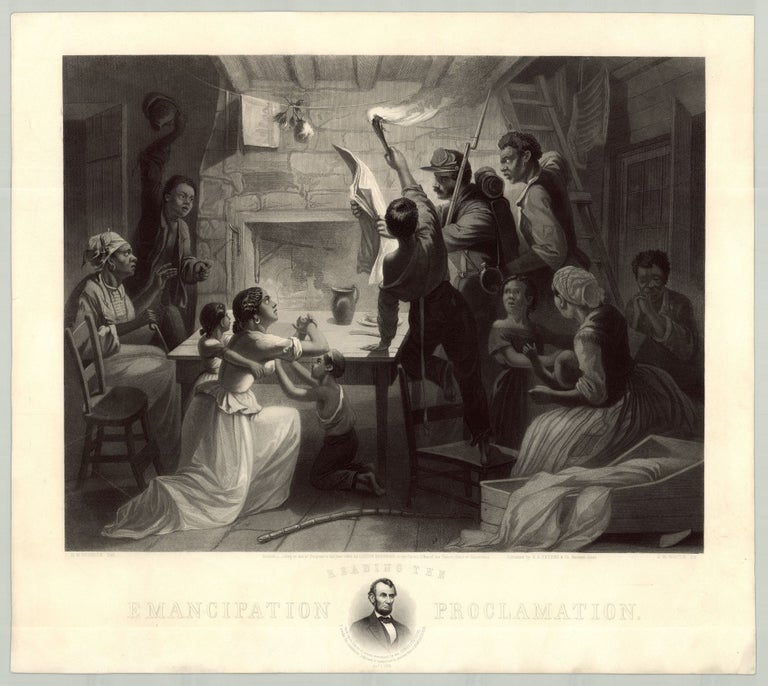Reading the Emancipation Proclamation.
[Hartford]: Lucius Stebbins, 1864. Steel engraving, 13.375” x 17.5” plus margins. CONDITION: Very good, expertly repaired tear to edge of image in title margin, a fewl light stains in margin, occasional patches of paper pulp reinforcement on verso. One of just a few prints published in the period immediately following the Emancipation Proclamation to portray a gathering of slaves receiving news of their liberation. This iconic engraving, based on a painting by artist Henry W. Herrick, depicts a slave family, and visitors in their cabin, gathered around a Union soldier as he reads the Proclamation from a newspaper. A torch held up by a boy illuminates both the newspaper and the reactions to this portentous announcement, which run the gamut from astonishment and jubilation to uncertainty and prayerfulness. When published, the print was accompanied by a pamphlet (not present here and rarely found with it), which included a “Description of the Engraving”:
Old man at the right with folded hands, Grand-father; old lady at the left with cane in hand, Grand-mother; man leaning on ladder, the father; woman with child in her arms, the mother; lad swings his hat, oldest son; little girl, oldest daughter; infant in the arms of its mother. Young woman with two children, the house servant of her master, not belonging to the cabin but happened to be in on the occasion. Party reading, Union soldier. The internal view of the cabin is true to nature. The stone chimney, garrett [sic], ladder, side of bacon, rough cradle, piece of sugar cane and cotton balls, etc., all combine to give a correct idea of the slaves home.
Publisher Lucius Stebbins provided further commentary on the print in an advertisement he included in a book entitled Life and Death in Rebel Prisons, which sheds some light on how it was meant to be viewed and by whom. Presenting it as a “new national engraving,” he noted:
This is a beautiful illustration of a great event in the world’s history—the emancipation of slavery in the United States will ever be so considered by all civilized nations for all time to come. The sight of this engraving will always produce happy reflections in the minds of every Christian and philanthropist, and should adorn the dwelling of every family in the country. It is the most appropriate illustration that can be made, as it represents the only way in which the glorious news could reach the downtrodden and oppressed slaves, viz.: through the faithful soldier, without whom the Proclamation would have remained a dead letter. The design is entirely original, by a bank note artist, and is truly elegant. The engraving is by one of the best workmen in the country, and is superbly executed.
A decidedly sympathetic depiction of African Americans, the print would likely have met with the approval of Frederick Douglass, who noted in a letter to Louis Prang praising the firm’s 1870 chromolithographic portrait of the first black U.S. Senator, Hiram Revels: “We colored men so often see ourselves described and painted as monkeys, that we think it a great piece of good fortune to find an exception to this general rule.”
Artist Henry Walker Herrick (1824–1926) was born in Hopkinton, New Hampshire, and worked as a wood-engraver in Concord and Manchester before moving to New York City in 1848, where he studied at the National Academy of Design, then worked for publishers and banknote companies. Herrick spent several years making engravings for New York publisher Appleton’s after illustrations by F. O. C. Darley, whose influence is evident in the painting upon which the present engraving is based. Herrick’s oil painting was exhibited at the National Academy of Design in 1865.
James W. Watts (d. 1895) was an engraver who began his career in Boston around 1848. According to Groce & Wallace, he worked for many years for the American Bank Note Company.
Book publisher Lucius Stebbins (1810–1901) began his career as a map colorist for Hartford map publisher D. F. Robinson, and also invented a machine that was used to color maps for Smith’s and Olney’s Geographies. Stebbins went on to become a subscription publisher, founding the American Publishing Company, best-known for its publication of a number of Mark Twain’s books.
REFERENCES: Holzer, Harold. “The Emancipation Proclamation in Art, Iconography, and Memory” in Holzer, Harold, et al. The Emancipation Proclamation : Three Views, Social, Political, Iconographic, (Baton Rouge, 2006), pp. 114–117.
Item #7145
Sold


